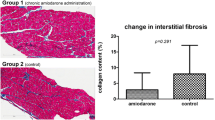Summary
We investigated the temporal and spatial development of infarcts in porcine hearts to evaluate the time-dependent beneficial effect of reperfusion on infarct size. The left anterior descending coronary artery (LAD) was occluded in 17 pigs for different periods of time followed by 4 hours of reperfusion. Transmural needle biopsies subdivided into subendocardial and subepicardial halves were taken from the ischemic apex after 60 min of ischemia to determine the tissue concentrations of ATP and NAD. The myocardium-at-risk was assessed with a fluorescent dye injected into the right atrium at the end of the experiments, just after the LAD had been reoccluded. The excised hearts were cut into slices parallel to the heart basis. The ischemic myocardium was measured by planimetry of the nonfluorescent areas whereas the infarcted tissue was determined with the NBT stain and related to the area-at-risk. Ischemic cell death started in the jeopardized left ventricular subendocardial septum after about 30 min of ischemia. The further progress involved the right subendocardial septum and the subendocardium of the left anterior free wall. Already after 75 min of ischemia most of the myocytes-at-risk were irreversibly injured.
Infarctions reached their final extent after 90–120 min of ischemia. These results indicate that in hearts without a significant collateral blood flow reperfusion can only reduce infarct size if its initiated within 60–75 min of ischemia. Like in canine hearts infarctions progress from the ischemic subendocardium towards the outer layers.
Similar content being viewed by others
References
Bretschneider HJ, Hellige G (1976) Pathophysiologie der Ventrikelkontraktion — Kontraktilität, Inotropie, Suffizienzgrad und Arbeitsökonomie des Herzens. Verh Dtsch Ges Kreislaufforsch 41:14–30
Eckstein RW (1954) Coronary interarterial anastomoses in young pigs and mongrel dogs. Circ Res 2:460–465
Fujiwara H, Ashraf M, Sato S, Millard RW (1982) Transmural cellular damage and blood flow distribution in early ischemia in pig hearts. Circ Res 51:683–693
Geary GG, Smith GT, McNamara JJ (1982) Quantitative effect of early coronary artery reperfusion in baboons. Circulation 66:391–396
Jennings RB, Hawkins HK, Lowe JE, Hill ML, Klotman S, Reimer KA (1978) Relation between high energy phosphate and lethal injury in myocardial ischemia in the dog. Am J Pathol 92:187–214
Jennings RB, Reimer KA (1979) Biology of experimental, acute myocardial ischemia and infarction. In: Hearse HDJ, de Leiris J, ed. Enzymes in Cardiology. John Wiley and Sons, Chichester New York Brisbane Toronto, 21–57
Klein HH, Schaper J, Puschmann St, Nienaber Ch, Kreuzer H, Schaper W (1981) Loss of canine myocardial nicotinamide adenine dinucleotides determines the transition from reversible to irreversible ischemic damage of myocardial cells. Basic Res Cardiol 76:612–621
Klein HH, Puschmann S, Schaper J, Schaper W (1981) The mechanism of the tetrazolium reaction in identifying experimental myocardial infarction. Virchows Arch (Pathol Anat) 393:287–297
Lochner W, Arnold G, Müller-Ruchholz ER (1968) Metabolism of the artificially arrested heart and of the gas-perfused heart. Am J Cardiol 22:299–311
Müller KD, Klein H, Schaper W (1980) Changes in myocardial oxygen consumption 45 minutes after experimental coronary occlusion do not alter infarct size. Cardiovasc Res 14:710–718
Nachlas MU, Shnitka TK (1963) Macroskopic identification of early myocardial infarcts by alteration in dehydrogenase activity. Am J Pathol 42:379–405
Neuhaus KL, Köstering H, Tebbe U, Sauer G, Kreuzer H (1981) Intravenöse Kurzzeitstreptokinase-Therapie beim frischen Myokardinfarkt. Z Kardiol 70:791–796
Patterson R, Kirk ES (1978) Coronary collaterals in pigs: physiologic and anatomic characterization. Circulation 57 II, 333 Abstract
Reimer KA, Lowe JE, Rasmussen MM, Jennings RB (1977) The wave front phenomenon of ischemic cell death. 1. Myocardial infarct size vs duration of coronary occlusion in dogs. Circulation 56:786–794
Rentrop P, Blanke H, Karsch KR, Kaiser H, Köstering H, Leitz K (1981) Selective intracoronary thrombolysis in acute myocardial infarction and unstable angina pectoris. Circulation 63:307–317
Row GG (1979) An angiographic and clinical study of coronary collateral circulation. Basic Res Cardiol 73:131–141
Schaper W (1971) The collateral circulation of the heart. In: Black DAK (ed) Clinical studies. North-Holland publishing company, Amsterdam London New York
Schaper W, Frenzel H, Hort W, Winkler B (1979) Experimental coronary artery occlusion II. Spatial and temporal evolution of infarcts in the dog heart. Basic Res Cardiol 74:233–239
Schaper W, Hofmann M, Müller KD, Genth K, Carl M (1979) Experimental occlusion of two small coronary arteries in the same heart. A new validation method for infarct size manipulation. Basic Res Cardiol 74:224–229
Schwarz F (1979) Correlation between the degree of coronary artery obstruction and myocardial dysfunction. In: Schaper W (ed) The pathophysiology of myocardial perfusion. Elsevier/North-Holland Biomedical Press. Amsterdam New York Oxford, pp 305–344
Verstraete M, Machin SJ (1980) Clinical usage of heparin. Present and future trends. Scand J Haematol Supp 36:1–188
White FC, Bloor CM (1981) Coronary collateral circulation in the pig: correlation of collateral flow with coronary bed size. Basic Res Cardiol 76:189–196
Wüsten B (1979) Biophysics of myocardial perfusion. In: Schaper W (ed) The pathophysiology of myocardial perfusion. Elsevier/North-Holland Biomedical Press. Amsterdam New York Oxford, pp 199–244
Author information
Authors and Affiliations
Additional information
This study was supported by a grant from SFB 89 Kardiologie, Göttingen
Rights and permissions
About this article
Cite this article
Klein, H.H., Schubothe, M., Nebendahl, K. et al. Temporal and spatial development of infarcts in porcine hearts. Basic Res Cardiol 79, 440–447 (1984). https://doi.org/10.1007/BF01908144
Received:
Issue Date:
DOI: https://doi.org/10.1007/BF01908144




